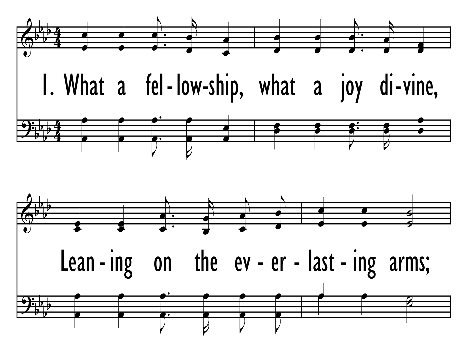- |
User Links
Leaning On the Everlasting Arms

What a fellowship, what a joy divine
Author: E. A. Hoffman (1887)Tune: SHOWALTER (Showalter 33321)
Published in 635 hymnals
Printable scores: PDFPlayable presentation: Lyrics only, lyrics + musicAudio files: MIDI, Recording
Representative Text
1 What a fellowship, what a joy divine,
leaning on the everlasting arms;
what a blessedness, what a peace is mine,
leaning on the everlasting arms.
Refrain:
Leaning, leaning,
safe and secure from all alarms;
leaning, leaning,
leaning on the everlasting arms.
2 O how sweet to walk in this pilgrim way,
leaning on the everlasting arms;
O how bright the path grows from day to day,
leaning on the everlasting arms. [Refrain]
3 What have I to dread, what have I to fear,
leaning on the everlasting arms?
I have blessed peace with my Lord so near,
leaning on the everlasting arms. [Refrain]
The United Methodist Hymnal, 1989
Author: E. A. Hoffman
 Elisha Hoffman (1839-1929) after graduating from Union Seminary in Pennsylvania was ordained in 1868. As a minister he was appointed to the circuit in Napoleon, Ohio in 1872. He worked with the Evangelical Association's publishing arm in Cleveland for eleven years. He served in many chapels and churches in Cleveland and in Grafton in the 1880s, among them Bethel Home for Sailors and Seamen, Chestnut Ridge Union Chapel, Grace Congregational Church and Rockport Congregational Church. In his lifetime he wrote more than 2,000 gospel songs including"Leaning on the everlasting arms" (1894). The fifty song books he edited include Pentecostal Hymns No. 1 and The Evergreen, 1873.
Mary Louise VanDyke… Go to person page >
Elisha Hoffman (1839-1929) after graduating from Union Seminary in Pennsylvania was ordained in 1868. As a minister he was appointed to the circuit in Napoleon, Ohio in 1872. He worked with the Evangelical Association's publishing arm in Cleveland for eleven years. He served in many chapels and churches in Cleveland and in Grafton in the 1880s, among them Bethel Home for Sailors and Seamen, Chestnut Ridge Union Chapel, Grace Congregational Church and Rockport Congregational Church. In his lifetime he wrote more than 2,000 gospel songs including"Leaning on the everlasting arms" (1894). The fifty song books he edited include Pentecostal Hymns No. 1 and The Evergreen, 1873.
Mary Louise VanDyke… Go to person page >Text Information
Related Texts
| First Line: | What a fellowship, what a joy divine |
| Title: | Leaning On the Everlasting Arms |
| Author: | E. A. Hoffman (1887) |
| Language: | English |
| Refrain First Line: | Leaning, leaning, safe and secure from all alarms |
| Publication Date: | 1887 |
| Notes: | Polish translation: See "Przyjaciela mam, co pociesza mnie" by Karol Hławiczka; Spanish translation: See "Dulce comunión que gozo ya" by Pedro Grado; Swahili translation: See "Ushirika mkuu, furaha yangu" |
| Copyright: | Public Domain |
Engish
English
- 20th Century Gospel Songs #23
- 20th Century Gospel Songs: Youthspiration Packet Hymnal #34
- 50 Favorites #27
- A choice collection of popular songs with some standard hymns for young people's meetings (Silver and Gold No. 1) #d144
- A Messenger for Jesus #d329
- A. M. E. C. Hymnal #188
- A.M.E. Hymnal: with responsive scripture readings...(The Richard Allen A.M.E. Hymnal) #d419
- African American Heritage Hymnal #371
- African Methodist Episcopal Church Hymnal #525
- Alexander's Hymns No. 3 #298 10 shown out of 476
Welsh
For Leaders
Text:
Anthony J. Showalter received letters from two friends who had lost their wives about the same time. He wrote back to express his sympathy, and included a verse of Scripture: “The eternal God is thy refuge, and underneath are the everlasting arms” (Deuteronomy 33:27 KJV). As he thought about that text, he wrote the music and refrain to this hymn. He asked Elisha Hoffman to write the stanzas. The hymn was first published in 1887 in The Glad Evangel for Revival, Camp, and Evangelistic Meetings, for which Showalter was an editor.
The text has three stanzas and a refrain. The theme of the text is the peace that comes from knowing that God will protect us, and how that knowledge removes our fears.
Tune:
The only tune to which this hymn is sung is SHOWALTER, written by the author, Anthony J. Showalter, when he wrote the text of the refrain. Sing in harmony, at least on the refrain, where the tenor and bass parts repeat “Leaning on Jesus” during the long notes of the women's voices.
When/Why/How:
This hymn is suitable for any time of year as a hymn of assurance. It can be sung in a variety of moods. The choral gospel medley “Back to the Church in the Wildwood,” which includes SHOWALTER, is written for a quick, upbeat tempo. A slower, peaceful mood also works well, as in this choral setting of “Leaning on the Everlasting Arms.” The melody is simple enough to permit expressive variation, such as in “Everlasting Arms.”
Tiffany Shomsky, Hymnary.org
Timeline
Arrangements
Media
The United Methodist Hymnal #133
- MIDI file from Baptist Hymnal 1991 #333
- Audio recording from Baptist Hymnal 1991 #333
- MIDI file from Baptist Hymnal 1991 #333
- Audio recording from Baptist Hymnal 2008 #453
- MIDI file from The Cyber Hymnal #3622
- Audio recording from Evangelical Lutheran Worship #774
- Audio recording from Glory to God: the Presbyterian Hymnal #837
- Audio recording from Small Church Music #92
- Audio recording from Small Church Music #92
- Audio recording from Small Church Music #92
- Audio recording from Trinity Hymnal (Rev. ed.) #616
- MIDI file from Timeless Truths #698
- Audio recording from The Worshiping Church #609
- MIDI file from The United Methodist Hymnal #133
- Audio recording from The United Methodist Hymnal #133
- MIDI file from Worship and Rejoice #496


 My Starred Hymns
My Starred Hymns







